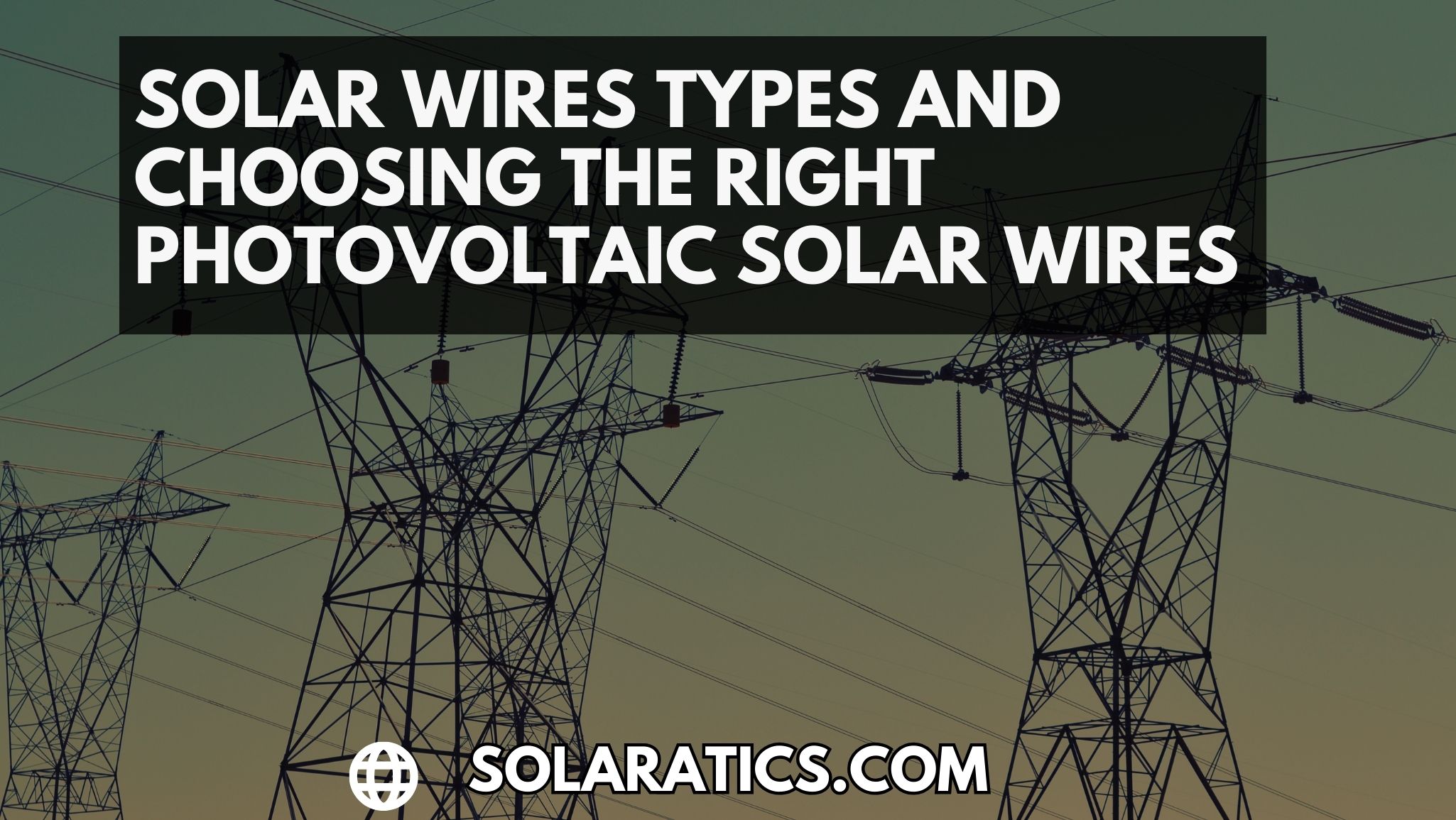Solar Wires Types & Choosing the Right Photovoltaic Solar Wires (Updated)

Solar wires, sometimes called solar cables or photovoltaic (PV) wires, are unique types of electrical cables developed for use with solar energy systems.
These lines are the lifeblood of a solar energy system, connecting solar panels, inverters, and anything else that uses electricity.
They are responsible for transporting the DC electricity produced by the solar panels to the inverter, which transforms the DC electricity into AC electricity. Here is a simple guide about solar wire types & choosing the right photovoltaic solar wires for your home.
Introduction

Solar power, which uses sunlight as a source of energy, has become increasingly popular in recent years due to its sustainability and renewable nature. It uses photovoltaic panels, which transform sunlight into power, to collect the sun’s rays.
While solar panels are essential, solar wires also play a significant part in this setup. This article will discuss solar wires, why they are necessary, and the various varieties available.
The qualities of high-quality solar wires, how to install and maintain them, how to keep them safe, and how to make the best possible choice when installing solar panels.
Difference Between Solar Cable and Normal Cable
Solar Cables
are specifically designed for use in photovoltaic (PV) systems. They are made with materials that can withstand the harsh outdoor conditions that PV systems are exposed to, such as UV radiation, extreme temperatures, and moisture.
Solar cables also have a high current-carrying capacity to handle the power generated by PV systems.
Regular Cables
are designed for a wider range of electrical applications. They are not as durable as solar cables and may not be able to withstand the harsh conditions of outdoor use.
Regular cables also have a lower current-carrying capacity than solar cables.
Types of Solar Wires

Solar wires come in a variety of forms, each optimized for a particular function inside a solar power installation. Educating yourself on the various options will allow you to select the best wiring for your solar system with confidence.
Here are three varieties of solar wires that are frequently used:
PV Wires (Photovoltaic)
The most popular kind of solar wires are photovoltaic wires, also known as PV wires. These cables can transport the direct current (DC) electricity produced by solar panels and are built to endure the elements.
Cross-linked polyethylene (XLPE) and polyvinyl chloride (PVC) are two common types of insulation used for PV wires because they are both long-lasting and resistant to moisture, ultraviolet light, and temperature changes.
They are available in a range of diameters and wire gauges, providing design freedom and the ability to handle a wide range of power densities.
Connecting Wires For Solar Panels

Connecting individual solar panels in an array requires the use of solar panel interconnect cables, also known as module interconnect wires.
These cables allow solar panels to be connected in series or in parallel, maximizing system voltage and current. Since they carry less electricity, solar panel connecting wires are typically smaller in diameter than PV wires.
Power transfer is facilitated while resistance losses are kept to a minimum.
Wiring For Solar Inverters
Wiring from the solar inverter to the electrical panel or grid connection point is what the term “solar inverter wires” refers to. These conductors transport the inverter’s alternating current electricity.
Which can be used to power residential or industrial appliances. Wires used in solar inverters tend to be larger and more powerful.
They are built to last, and they are compliant with AC wiring regulations so that power may be sent without interruption.
Key Considerations For Solar Wires
Several crucial factors must be taken into mind while dealing with solar wires. Here are a few things to keep in mind:

Sizing And Gauge of Wires
The effectiveness of a solar energy system is directly related to the wire’s diameter and thickness. The current from the solar panels must be safely carried by the wire.
Voltage drop and energy losses can occur when using undersized wire. Determine the appropriate wire gauge for your installation by consulting the electrical code or a specialist.
Insulation And Durability
Solar wires are constantly subjected to the elements, including direct sunlight, heat, moisture, and wide swings in temperature.
For this reason, insulating materials such as cross-linked polyethylene (XLPE) or ethylene propylene rubber (EPR) should be sought out for use in wires. If you want to know which battery is best for your solar panel then click here to know.
To maintain its effectiveness over time, the insulation must be resistant to things like sunlight and weather.
Rating of Voltage
Low-voltage direct current (DC) electricity is produced by solar systems. Choosing wires with a voltage rating appropriate for the system’s voltage level is crucial.
As a matter of safety and to avoid electrical breakdown, the voltage rating needs to be higher than the maximum voltage produced by the solar panels.
Safety From Flames
The potential for fires caused by solar cables can be reduced if they have suitable fire-resistant qualities.
Try to find wires that have been certified as safe for use around open flames by organizations like UL 4703 and UL 854.
Compliance With Standards

Make sure the solar lines are certified and up to code with organizations like the National Electrical Code (NEC) and the International Electrotechnical Commission (IEC).
The quality and safety of the wires are dependent on their conformance to certain requirements.
Drop-In Voltage And Length
Think about how far away your solar panels are from your inverter and batteries. Longer wire runs can cause voltage drops, which reduces the efficiency of the system.
For optimum performance, you’ll want to figure out the voltage drop by figuring out the wire length, the current, and the wire gauge.
Material of A Conductor
Conductor materials like copper and aluminum are often utilized in solar cables. Copper’s superior conductivity and corrosion resistance come at a price, however.
Aluminum wires can be less expensive, but their lesser conductivity means they need bigger gauge sizes.
Proper Installation
In order to maximize efficiency and ensure safety, solar wiring must be installed correctly. The cables must be routed properly, attached securely, and shielded from potential danger.
Make sure to read the manual and talk to an electrician or solar technician before beginning the installation process.
Putting In Place Solar Wires
A specific order of operations must be followed when installing solar wires for a solar energy system. In order to assist you, we have compiled the following guidelines:

Administration of Wiring Systems
Solar cables must be routed and managed correctly to preserve the integrity of the system and prevent voltage drops and other risks. Protect wires from injury by installing them far from any sharp or moving edges or parts.
Electrical Terminals And Receptacles
To guarantee safe and dependable connections between cables and system components, use high-quality connectors and junction boxes.
Resistance and power losses can be reduced by using connections of the right size and the proper wiring techniques.
Connection And Rooting
Protect the system from electrical faults, lightning strikes, and ground potential rise by following grounding and bonding rules. The security of the system and its users depends on its grounding.
Maintenance And Troubleshooting of Solar Wires

Constant Verification
Solar wires should be inspected on a regular basis to ensure their condition has not deteriorated. Look for any signs of corrosion, loose connections, or other problems that could reduce the efficiency of the system.
Repairing And Securing Wires
Prevent the solar wires from being harmed by abrasion or the elements. If faulty wiring is found, it must be fixed or replaced immediately to ensure reliable power delivery.
Wiring Problem Diagnosis And Repair

If there are problems with the system’s functionality or electricity, you should check the wiring and parts. Locate and fix any frayed or disconnected wires so that the system can function properly and safely.
Conclusion

The efficiency and dependability of solar power plants are greatly aided by solar wires. Maximizing your solar array’s output requires that you give careful consideration to the selection, installation, and maintenance of the wires that carry electricity.
When making decisions for your solar project, keep in consideration the wire size, insulation, durability, and compliance with safety standards.
Maintaining the system’s efficacy and lifetime requires routine inspection and rapid troubleshooting of wiring faults.
Also Read: How to Check If Your Solar Panels Are Working? (Simple Guide)
